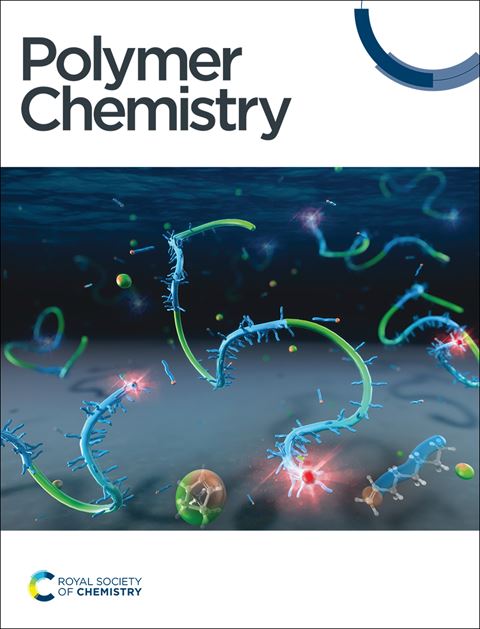由聚(草冰片烯)前体聚合物衍生的免疫刺激ph响应纳米凝胶
IF 3.9
2区 化学
Q2 POLYMER SCIENCE
引用次数: 0
摘要
开环复分解聚合(ROMP)提供了明确定义的聚(草冰片烯)嵌段共聚物,可以转化为胶束衍生的免疫活性纳米凝胶。我们报道了基于氧生冰片烯衍生的聚合后修饰策略的这种免疫活性纳米凝胶的合成。在第三代Grubbs催化剂(G3)催化下,采用开环复分解聚合(ROMP)方法合成了关键前驱体氧生片烯五氟苯基酯(ONB-PFP)单体,实现了高效的活性嵌段共聚。该方法通过将活性酯单体与亲水性三乙烯二醇功能化的草冰片烯结合,产生了定义良好的嵌段共聚物,为随后的聚合后修饰建立了强大的平台。嵌段共聚物在水中自组装形成纳米凝胶,使用不同的交联剂生成酸不稳定(D-NG)和不可降解(ND-NG)纳米凝胶,而不使用交联剂获得完全亲水的单聚合物链作为对照。toll样受体7/8激动剂IMDQ(一种免疫调节咪唑喹啉剂)与纳米凝胶共价附着产生免疫活性纳米凝胶,其免疫刺激效果在体外使用RAW-Blue巨噬细胞报告细胞系进行了评估。流式细胞术证实了巨噬细胞对完整纳米凝胶的有效摄取,导致受体激活,从而为安全控制高效TLR7/8激动剂的递送提供了一种策略。本文章由计算机程序翻译,如有差异,请以英文原文为准。
Immunostimulatory pH-responsive Nanogels Derived from Poly(oxanorbornene) Precursor Polymers
Ring Opening Metathesis Polymerization (ROMP) provides access to well-defined poly(oxanorbornene) block copolymers that can be converted into micellar-derived immunoactive nanogels. We report on the synthesis of such immunoactive nanogels based on oxanorbornene-derived post-polymerization modification strategy. The key precursor, an oxanorbornene pentafluorophenyl ester (ONB-PFP) monomer, was synthesized and polymerized using living ring-opening metathesis polymerization (ROMP) facilitated by a third-generation Grubbs catalyst (G3) for efficient living-type block copolymerization. This approach yielded well-defined block copolymers by incorporating an active ester monomer with a hydrophilic triethylene glycol-functionalized oxanorbornene, establishing a robust platform for subsequent post-polymerization modifications. Nanogels were formed by aqueous self-assembly of the block copolymers, with various crosslinking agents employed to generate both acid-labile (D-NG) and non-degradable (ND-NG) nanogels, while without crosslinkers fully hydrophilic single polymer chains were obtained as controls. The covalent attachment of the Toll-like receptor 7/8 agonist IMDQ, an immunomodulatory imidazoquinoline agent, to the nanogels produced immunoactive nanogels, whose immunostimulatory efficacy was evaluated in vitro using a RAW-Blue macrophage reporter cell line. Flow cytometry confirmed efficient cellular uptake of only the intact nanogels by the macrophages resulting in a receptor activation and thus providing a strategy to safely control the delivery of the highly potent TLR7/8 agonist.
求助全文
通过发布文献求助,成功后即可免费获取论文全文。
去求助
来源期刊

Polymer Chemistry
POLYMER SCIENCE-
CiteScore
8.60
自引率
8.70%
发文量
535
审稿时长
1.7 months
期刊介绍:
Polymer Chemistry welcomes submissions in all areas of polymer science that have a strong focus on macromolecular chemistry. Manuscripts may cover a broad range of fields, yet no direct application focus is required.
 求助内容:
求助内容: 应助结果提醒方式:
应助结果提醒方式:


